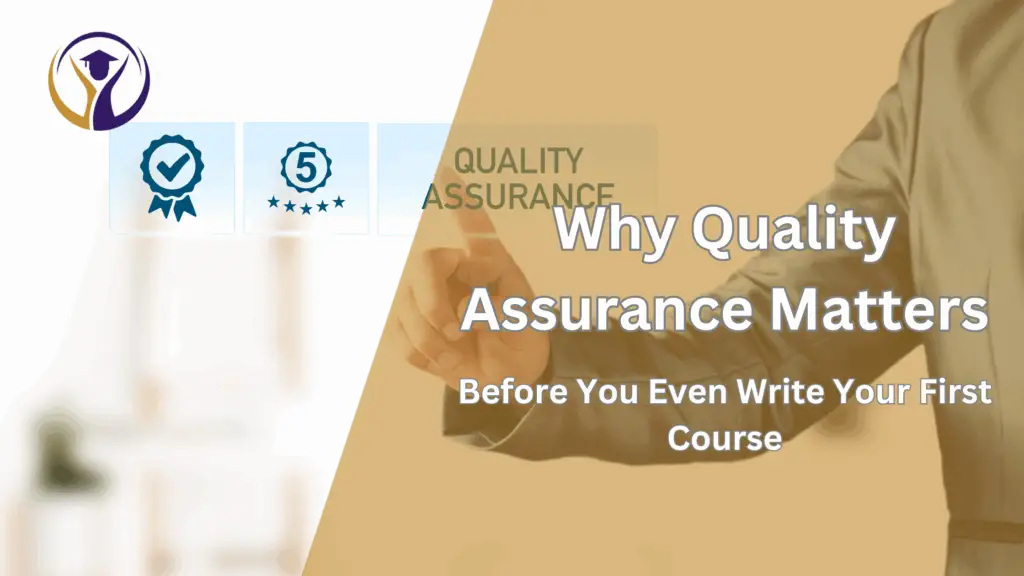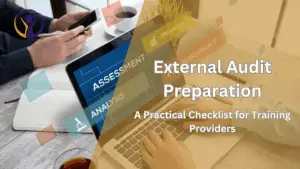How building QA into course design saves time, boosts learner outcomes, and keeps you compliant from day one. When creating a new training programme, most providers get excited about building the course content — choosing topics, designing slides, or drafting assessments. But there’s something just as important, and it needs to happen first: quality assurance.
At CQAS, we often support training providers and educational institutions who’ve run into problems — courses that failed to align with validation criteria, assessments that didn’t meet learning outcomes, or paperwork that couldn’t stand up to internal or external review.
These issues all point to one thing: quality assurance in course design should start before you write a single learning outcome.
1. Why Starting Without QA Leads to Problems
Without QA, your course might look good at first — but underneath, cracks start to form:
Assessments that don’t match the intended learning outcomes
Poor learner progression due to unclear support structures
Incomplete or inconsistent documentation
Stressful reworks before validation or audits
Delays in programme approval by awarding bodies
Negative learner feedback from unclear structure or delivery
When these problems arise late in the process, they’re harder — and more expensive — to fix. If your course isn’t mapped out with compliance in mind, you’re not just at risk of failed reviews, you’re also risking your learners’ experience and your organisation’s reputation.
Want to avoid this? That’s where our Documentation Support Service and Assessment Management can help from the start.
2. What QA-First Course Development Actually Looks Like
A “QA-first” approach doesn’t mean loads of extra work — it simply means embedding structure, standards, and learner focus into the development process.
Here are four core QA elements you should have in place before you begin creating content:
1. Intended Learning Outcomes (ILOs)
Good course design starts with the end in mind. Your ILOs should clearly state:
What learners should know, understand, or be able to do by the end of the course
How these outcomes align with the National Framework of Qualifications (NFQ) or your awarding body’s framework
The appropriate level of learning (e.g., QQI Level 5 vs. Level 6)
Using structured ILOs ensures your assessments and content stay focused — and it gives your learners clarity about what success looks like.
2. Assessment Mapping and Fairness
Your assessments need to do more than test knowledge — they should map directly to your ILOs. Ask yourself:
Does each assessment task link clearly to at least one outcome?
Are the assessment criteria measurable and transparent?
Are assessments fair, accessible, and inclusive?
This is a common area where courses fall short during audits or validation. Our Assessment Management Service supports providers in mapping, moderating, and validating assessments across all formats.
3. Learner Support Structures and Policies
Even the best-designed courses can fail if learner supports aren’t in place. From access and progression to complaints and appeals, your QA framework must show:
How learners are supported throughout their journey
That fair, transparent systems exist to manage any issues
That you have a clear policy framework for tutors and learners
CQAS supports providers through our Educational Compliance Service, helping you align with QQI, PHECC, and other frameworks without overcomplicating your operations.
4. Robust QA Documentation
Without documentation, there’s no proof your processes exist — or that they’re being followed.
From attendance sheets and marking rubrics to tutor handbooks and version-controlled policies, your documentation should be structured, accessible, and up to date. These documents not only support delivery but are vital during internal reviews or reengagement with bodies like QQI.
Need templates, policy support, or a documentation audit? Our Educational Quality Assurance team can help.
3. The Strategic Advantage of QA-Driven Design
QA isn’t just about compliance — it’s about quality. A QA-first approach gives you:
Clear course structure from the start
Faster validation or approval from awarding bodies
Fewer learner complaints or confusion
Better tutor guidance and delivery consistency
Easier internal reviews, audits, and updates
Ultimately, it shows that your organisation values its learners, staff, and standards.
4. How CQAS Supports Course Developers
We work with providers at all stages — from early concept planning to post-launch internal audits. Whether you’re delivering manual handling, healthcare, digital skills, or any other subject, CQAS offers:
QA documentation and policy templates
Support with assessment and marking guides
Internal audits based on National or bespoke standards
Blended learning quality policies
General compliance advice and quality reviews
If you’re developing a course or expanding your training services, we can help make sure it’s built on solid QA foundations.
5. Quality Assurance in Course Design Builds Long-Term Success
It’s easy to treat quality assurance as a checklist — something to be ticked off before submission or audit. But the real benefit of embedding quality assurance in course design is long-term sustainability.
When QA is part of your design process, you’re not just building a course — you’re building a framework that can grow with your organisation. This means:
New tutors can pick up and deliver consistently
Learner feedback can be mapped and acted on
Assessments can be adjusted without losing alignment
The course can scale, be revalidated, or adapted for blended delivery with ease
At CQAS, we help providers design with the future in mind. Whether you’re launching a new training programme or reviewing an old one, QA isn’t just about passing audits — it’s about building quality that lasts.
6. Final Thought
Don’t wait until your course is finished to think about quality. By prioritising quality assurance in course design from the very beginning, you save time, improve learner outcomes, and reduce the risk of compliance issues down the line.
Whether you’re new to course development or updating existing programmes, our team at CQAS is here to support you every step of the way.
👉 Contact CQAS today and let’s ensure your course is built with quality — and confidence — from day one.


